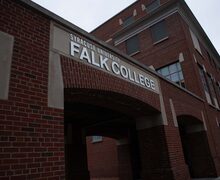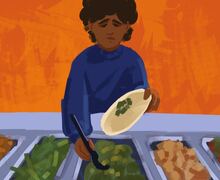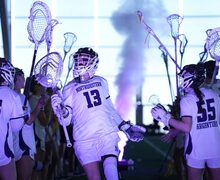Final Community Grid Vision Plan open house discusses transportation, housing concerns
Solange Jain | Asst. Photo Editor
Community members gather at Tucker Missionary Baptist Church to discuss plans for city infrastructure following the removal of the I-81 viaduct. Joe Driscoll presented sketches for future Syracuse streets after the destruction of the viaduct, prompting community discussion.
Get the latest Syracuse news delivered right to your inbox.
Subscribe to our newsletter here.
The city of Syracuse hosted its fifth and final neighborhood open house in the Southside neighborhood Monday evening, concluding efforts to collect community input on Mayor Ben Walsh’s Community Grid Vision Plan.
Throughout the meeting, attendees offered mixed reactions to the plan, which was presented by Joe Driscoll, the appointed Interstate-81 City Project director. Community members expressed concerns regarding the potential for increased traffic flow, displacement of existing communities and a lack of accessibility to bike routes.
“It’s about people. It’s not about dollars and cents and how much money (is) saved. It’s about the people, the taxpayer, citizens that live in this neighborhood,” said Debra King, a resident of the Southside neighborhood.
The 56-page plan, first announced in February, details recommendations for enhancing the city’s transportation systems, land use, housing developments and pedestrian accommodations following the demolition of the I-81 viaduct — which historically displaced Black communities and contributed to racial segregation in Syracuse.
“There are other things we have to do to help traffic flow, to help make it more walkable and bikeable and make the community flow differently than it currently flows in a reconfigured Syracuse,” Driscoll said.
As projects are currently in early stages, urban planners Dover, Kohl, & Partners are still open to community feedback, Driscoll said. Ahead of the initiation of these projects, Walsh announced on July 18 that the city would hold open houses throughout the summer across five Syracuse neighborhoods: Westside, Northside, Downtown, Eastside and Southside.
Walsh, who was not in attendance at Monday’s meeting, has previously said the goal of the project is to maximize the positive impact of the I-81 viaduct removal and subsequent establishment of a community grid. The grid is meant to increase mobility and access for local neighborhoods.
The newly proposed city housing plan focused primarily on building row houses, a series of houses connected via sidewalls with identical infrastructure, instead of the separate houses surrounding Dr. King Elementary School in the Southside neighborhood.
King shared her perspective on the newly proposed changes surrounding Dr. King Elementary School during the forum. Throughout her remarks, King emphasized her belief that the residents deserve to have a say in the changes being made in their community.
“You’re displacing a lot of people. You only have to have so many units to be considered low-income,” King said.
Some other attendees similarly expressed concerns with the row house approach. One said they feared that, since all the units share the same infrastructure, problems in one home — such as infestations — may spread to others in the development. Another community member said they thought the plan could limit backyard space and impact local childrens’ ability to play outdoors.
In the meeting, multiple community members also said they believed the plan catered to local universities, namely Syracuse University and SUNY Upstate Medical University, rather than residents of the inner city communities.
It's about the people, the taxpayer, citizens that live in this neighborhood.Debra King, Southside resident
Following the meeting, Director of East Adams Neighborhood Redevelopment Sarah Walton reflected on the open house and some of the criticisms that arose following the presentation. The East Adams neighborhood is set to undergo public housing redevelopments, the addition of new bus lanes and creation of dedicated bike lanes.
“My main takeaway is that there are a lot of ways that people want to see the community look,” Walton said. “There is going to be a lot of change on the horizon, and there’s not one perfect solution.”
Attendees of Monday’s open house also discussed connectivity between neighborhoods. Both attendees and speakers highlighted the creation of new bike lanes and walkways as a means of increasing accessibility for neighborhood communities.
Driscoll proposed possible adjustments to the area surrounding Dr. King Elementary School, including building a street behind the school. This came after the neighborhood had faced ongoing debate about a proposed roundabout, which was then set for Van Buren Street in September 2023.
A $40 million bus rapid transport system for Centro is also part of Walsh’s plan, Driscoll said. Instead of having a fixed bus schedule with around 40 minutes between each arrival time, buses would come between five and 10 minutes apart under the new system, he said.
Driscoll also referenced the plan’s connection with the Vision Zero Initiative, a strategy for reducing traffic fatalities and injuries.
Kathy Downing, a local teacher and SU graduate, said she is a strong supporter of the bus rapid transport system and the city’s efforts of improving public transportation.
Downing, who said she frequently attends public events, raised her hand to share her thoughts on the changes to the transportation system. As someone whose primary form of transportation is biking, she advocated for better-designed and protected bike lanes.
“When we have bike lanes that just stop all of a sudden, it is hard here,” Downing said. “I can think of so many where they just stop.”
City officials are still gathering feedback and suggestions from residents. Driscoll has set forth a structure of speaking to community members and soliciting their input to draft the outlines for potential enhancements. With the conclusion of five neighborhood open houses, Driscoll and his team now plan to consider community responses.
Published on August 27, 2024 at 2:01 am
Contact Madeline: mmgoodhe@syr.edu





